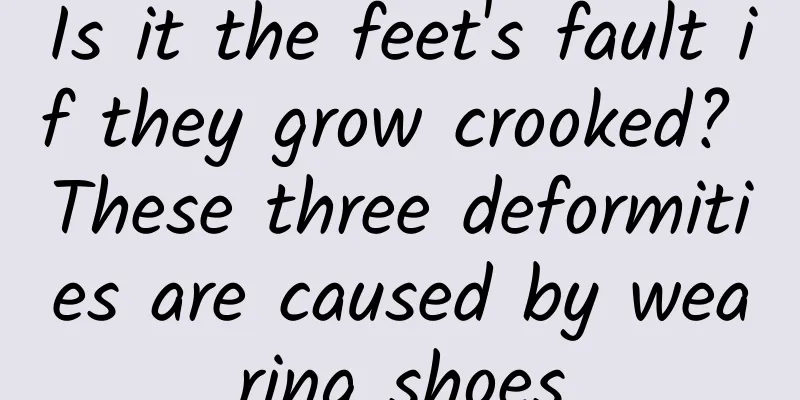Is it the feet's fault if they grow crooked? These three deformities are caused by wearing shoes

|
"Three-inch golden lotus" is a bad custom in ancient China. When a girl is six or seven years old, her feet are wrapped with long strips of cloth, and external force is applied to make her feet deformed. This is a dehumanizing practice, and ancient women suffered a lot because of it. However, in modern times, even though the bad custom of foot binding has disappeared, there are still people who suffer from similar pain because they suffer from toe deformities. Toe deformities are very common among women and the elderly. Although beautiful shoes can hide the deformed toes, the pain of wearing shoes is unbearable. 01 What kind of disease is toe deformity? Human toes are made up of multiple toe bones, which are connected by muscles and ligaments. The joint between two toe bones is called the interphalangeal joint. Some congenital or acquired factors cause toe muscle contracture, resulting in one or more interphalangeal joints and metatarsophalangeal joints being unable to flex and extend normally and freely, thus forming toe deformities. According to the different forms of toe deformities, they are divided into hammer toes , hammer toes and claw toes . Next, let’s talk specifically about these three common toe deformities. Copyright image, no permission to reprint 02 Hammer toes, mallet toes, and claw toes Hammer toes, hammer toes and claw toes are common deformities of the 2-4 toes of the forefoot, and many people confuse them. In fact, although hammer toes, hammer toes and claw toes are all foot deformities caused by imbalance of toe muscle tendons or ligaments, they are different. The picture comes from the Internet 1. Hammertoe Hammer toe refers to the terminal flexion deformity of the toe caused by flexion of the metatarsophalangeal joint and proximal interphalangeal joint of the affected toe, which looks like a "hammer" and is named after it. 2. Hammer toe Hammer toe is the most common toe deformity in clinical practice. It refers to the neutral position or dorsiflexion of the metatarsophalangeal joint of the affected toe, flexion of the proximal interphalangeal joint, and neutral position or dorsiflexion of the distal interphalangeal joint, resulting in flexion deformity of the middle part of the toe. 3. Claw toes Claw toes are caused by excessive upward bending of the metatarsophalangeal joints and excessive flexion of the interphalangeal joints, which make the toes claw-shaped. For those with mild deformities, the toe deformity can basically disappear when standing and bearing weight. For those with severe deformities, the deformed toes appear completely bent and cannot be straightened [1]. So, what causes toe deformities? 03 Causes of toe deformities There are many reasons for toe deformity, mainly lesions caused by mechanical factors , disease factors and traumatic factors . 1. Mechanical factors Mechanical factors are the main cause of hammer toes and mallet toes, mainly caused by wearing inappropriate shoes for a long time , especially high heels or shoes that are too tight or too narrow [1]. The structure of the foot is quite special. If the toe muscles lose their activity and become unbalanced, the interphalangeal joints and metatarsophalangeal joints are under excessive pressure, and the muscles and ligaments are diseased, deformities will occur. Copyright image, no permission to reprint 2. Disease factors Arthritis or sequelae of anterior horn poliomyelitis, cerebral palsy, spinal cord dysfunction and hallux valgus can all cause toe muscle neuropathy, resulting in inability to flex and extend the interphalangeal joints and metatarsophalangeal joints normally, thus causing claw toes[1]. 3. Traumatic factors Trauma can cause damage to the soft tissue of the toes, which in turn can lead to muscle and ligament contracture after healing, causing corresponding deformation of the interphalangeal joints and metatarsophalangeal joints, thus causing toe deformities[1]. Besides these, there are some other factors that can also cause hammer toes, mallet toes and claw toes. They are as follows: Incorrect gait, such as walking inward or outward, causes excessive pressure and friction on the toes. The older you are, the more likely you are to develop hammer toes, and women are at higher risk. Being overweight causes long-term weight bearing on the feet. If the second toe is longer than the big toe, the risk is greater. There is a family history of hammer toes, mallet toes and claw toes, etc. 04 How to correct toe deformity? Toe deformities must be treated promptly , because as the disease progresses, toe deformities will gradually worsen, joint stiffness will occur, and other foot deformities will be triggered, seriously affecting the patient's normal life. 1. First of all, we need to remove mechanical stimulation factors, wear comfortable shoes, socks and insoles , and develop good walking habits. Copyright image, no permission to reprint 2. Mild deformities can be corrected and treated to restore the appearance and function of the foot. Special orthotics or even special orthopedic shoes can be worn to relieve pain and prevent the toe deformity from getting worse. 3. Patients who have failed non-surgical treatment or have severe toe deformities should actively seek medical treatment and cooperate with doctors for surgical treatment. There are two main types of surgery: soft tissue surgery and bone and joint surgery. The goal of soft tissue surgery is to correct the toe deformity by transferring the long flexor tendons of the toes to the dorsiflexor tendons [1]. The goal of bone and joint surgery is to fuse the interphalangeal joints and correct toe deformities [1]. Copyright image, no permission to reprint 4. During the recovery period of orthopedic treatment, you can perform appropriate toe exercises , such as picking up a small ball with your feet or grabbing a towel with your feet. These exercises can effectively train the muscle strength and control of the toes and help strengthen and stretch the tendons and ligaments of the feet [1]. 5. Targeted toe physical therapy can strengthen muscle strength and stretch tense muscles, which is very beneficial for the rehabilitation of hammer toes, mallet toes, and claw toes. The feet are the strength support of the whole body and the foundation of the human body, so it is very important to maintain the normal function of the feet. Deformities of the toes mean that the foot function is abnormal, and the mechanical transmission of the sole of the foot may be hindered, which will affect the overall mechanical arrangement of the person. Therefore, everyone must pay attention to foot health and treat problems as soon as possible. References: [1] Xiao Fajiao, Yang Yunfeng. Research progress of interphalangeal arthrodesis. Chinese Journal of Reparative and Reconstructive Surgery, 2020, 34(9):1195-1199. Produced by | Popular Science China Medical Health Review | Zhang Jianzhong, Chief Physician, Beijing Tongren Hospital, Capital Medical University The cover image and the images in this article are from the copyright library Reproduction of image content is not authorized |
<<: Catch single atoms in a "trap" to measure the age of ice cores
>>: Stress leads to obesity! How to break out of the vicious cycle of "stress → eating → stress"?
Recommend
United Nations Environment Programme: Emissions Gap Report 2024
UNEP has published its 2024 Emissions Gap Report,...
Where does the water on Earth come from? my country's latest scientific research results provide new ideas for understanding the evolution of life
Image source: Tuchong Creative There are many dif...
Dapeng Education-【Chinese Painting Academy】0904 Flower and Bird Special Enhancement Course
Dapeng Education - [Chinese Painting Academy] 090...
What happens when you contribute code to open source every day for a year
My requirements for contributing code are relativ...
Apple releases iOS 15.5 official version: smoother, supports third-party payment for some apps
In the early morning of May 17th, Beijing time, A...
China's entire financial system: a comprehensive list of financial regulation, institutional operations and products
Comprehensively understand domestic financial sup...
Interesting Talk | If AI has autonomous consciousness, where will humanity go?
The topic of AI has been discussed for many years...
How to improve conversion rate and encourage users to place more orders?
There are many scenarios for users to place order...
The formula for becoming a Tik Tok influencer worth $1 million!
Tik Tok has become more and more popular, and var...
Microsoft realizes airborne control of mobile phones
Microsoft researchers recently announced that they...
Jiaqi: New Era Chat Black Technology - Hunting Heart Law
Jiaqi's "New Era Chat Black Technology -...
Turtle Class·TikTok Becomes Reality Training Camp Online 4th Video
Tik Tok is a popular app this year, and its globa...
The "Song" is here, creating an era of SUV fuel consumption 3! Song L DM-i is launched with a shocking price of 135,800 yuan
On July 25, BYD Dynasty's new mid-size SUV So...
Douyin Training Camp Project Practice (Operation)
As the pressure of employment competition becomes...
Review of the new toy for geeks: Baofeng Magic Mirror 3 plus
At this year's E3 exhibition, Microsoft's...









